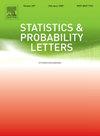Variable-selection consistency of linear quantile regression by validation set approach
IF 0.7
4区 数学
Q3 STATISTICS & PROBABILITY
引用次数: 0
Abstract
We consider the problem of variable selection in the quantile regression model by cross-validation. Although cross-validation is commonly used in quantile regression for model selection, its theoretical justification has not yet been verified. In this work, we prove that cross-validation with the check loss function can lead to variable-selection consistency in quantile regression. Specifically, we investigate its asymptotic properties in linear quantile regression and its penalized version under both fixed and diverging number of parameters. For penalized models, penalties with the oracle property combined with cross-validation are shown to provide variable-selection consistency. In general, one of the crucial requirements for this consistency to hold is that the validation set size should be asymptotically equivalent to the total number of observations, which is also required in the conditional mean linear regression.
验证集法的线性分位数回归变量选择一致性
通过交叉验证,我们考虑了分位数回归模型中变量选择的问题。虽然交叉验证通常用于分位数回归模型选择,但其理论合理性尚未得到验证。在这项工作中,我们证明了与检查损失函数的交叉验证可以导致分位数回归中变量选择的一致性。具体地,我们研究了它在线性分位数回归中的渐近性质,以及它在参数数量固定和发散情况下的惩罚形式。对于惩罚模型,结合了oracle属性和交叉验证的惩罚可以提供变量选择的一致性。一般来说,保持这种一致性的关键要求之一是验证集的大小应该渐近地等于观察值的总数,这也是条件平均线性回归所要求的。
本文章由计算机程序翻译,如有差异,请以英文原文为准。
求助全文
约1分钟内获得全文
求助全文
来源期刊

Statistics & Probability Letters
数学-统计学与概率论
CiteScore
1.60
自引率
0.00%
发文量
173
审稿时长
6 months
期刊介绍:
Statistics & Probability Letters adopts a novel and highly innovative approach to the publication of research findings in statistics and probability. It features concise articles, rapid publication and broad coverage of the statistics and probability literature.
Statistics & Probability Letters is a refereed journal. Articles will be limited to six journal pages (13 double-space typed pages) including references and figures. Apart from the six-page limitation, originality, quality and clarity will be the criteria for choosing the material to be published in Statistics & Probability Letters. Every attempt will be made to provide the first review of a submitted manuscript within three months of submission.
The proliferation of literature and long publication delays have made it difficult for researchers and practitioners to keep up with new developments outside of, or even within, their specialization. The aim of Statistics & Probability Letters is to help to alleviate this problem. Concise communications (letters) allow readers to quickly and easily digest large amounts of material and to stay up-to-date with developments in all areas of statistics and probability.
The mainstream of Letters will focus on new statistical methods, theoretical results, and innovative applications of statistics and probability to other scientific disciplines. Key results and central ideas must be presented in a clear and concise manner. These results may be part of a larger study that the author will submit at a later time as a full length paper to SPL or to another journal. Theory and methodology may be published with proofs omitted, or only sketched, but only if sufficient support material is provided so that the findings can be verified. Empirical and computational results that are of significant value will be published.
 求助内容:
求助内容: 应助结果提醒方式:
应助结果提醒方式:


